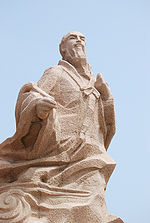Xu Fu: Difference between revisions
The character "福" is read as "fuku" in Japanese. Not "foku" |
no way for us to verify what he did after he died. |
||
| Line 1: | Line 1: | ||
[[Image:XuFu.jpg|thumb|Xu Fu]] |
[[Image:XuFu.jpg|thumb|Xu Fu]] |
||
[[image:Jofuku park03bs1600.jpg|180px|thumb|Statue of Xu Fu,Shingu City,Japan]] |
[[image:Jofuku park03bs1600.jpg|180px|thumb|Statue of Xu Fu,Shingu City,Japan]] |
||
'''Xú Fú''' ([[Chinese language|Chinese]]: 徐福 or 徐[[Wiktionary:巿|巿]], not to be confused with the character [[Wiktionary:市|市]], [[Japanese language|Japanese]]: '''Jofuku''' 徐福) was born in 255 BC in the [[Qi (state)|Qi]] state and served as a court sorcerer in [[Qin Dynasty|Qin Dynasty China]] |
'''Xú Fú''' ([[Chinese language|Chinese]]: 徐福 or 徐[[Wiktionary:巿|巿]], not to be confused with the character [[Wiktionary:市|市]], [[Japanese language|Japanese]]: '''Jofuku''' 徐福) was born in 255 BC in the [[Qi (state)|Qi]] state and served as a court sorcerer in [[Qin Dynasty|Qin Dynasty China]]. He was sent by [[Qin Shi Huang]] to the eastern seas twice to look for the [[elixir of life]].<ref name="Lee1">Lee, Khoon Choy Lee. Choy, Lee K. [1995] (1995). Japan--between Myth and Reality: Between Myth and Reality. World Scientific publishing. ISBN 9810218656, 9789810218652.</ref> His two journeys occurred between 219 BC and 210 BC. It was believed that the fleet included 60 [[barque]]s and around 5000 crew members, 3000 boys and girls<ref name="Lee1" />, and craftsmen of different fields. After he embarked on a second mission in 210 BC, he never returned. Some sources have pointed to 500 boys and 500 girls instead.<ref name="Liu">Liu, Hong. The Chinese Overseas: Routledge Library of Modern China. Published by Taylor & Francis, [2006] (2006). ISBN 041533859X, 9780415338592.</ref> Various records suggest that he may have arrived and died in [[Japan]]. |
||
==Voyage== |
==Voyage== |
||
Revision as of 03:19, 10 January 2010
Xú Fú (Chinese: 徐福 or 徐巿, not to be confused with the character 市, Japanese: Jofuku 徐福) was born in 255 BC in the Qi state and served as a court sorcerer in Qin Dynasty China. He was sent by Qin Shi Huang to the eastern seas twice to look for the elixir of life.[1] His two journeys occurred between 219 BC and 210 BC. It was believed that the fleet included 60 barques and around 5000 crew members, 3000 boys and girls[1], and craftsmen of different fields. After he embarked on a second mission in 210 BC, he never returned. Some sources have pointed to 500 boys and 500 girls instead.[2] Various records suggest that he may have arrived and died in Japan.
Voyage
The ruler of Qin, Qin Shi Huang feared death and sought a way to live forever. He entrusted Xu Fu with the task of finding the secret of immortality. In 219 BC, Xu Fu was sent with three thousand virgin boys and girls to retrieve the elixir of life from the immortals, including Anqi Sheng, who lived on Penglai Mountain in the eastern seas. Xu sailed for several years without finding the mountain. In 210 BC, when Qin Shi Huang questioned him, Xu Fu claimed there was a giant sea creature blocking the path, and asked for archers to kill the creature. Qin Shi Huang agreed, and sent archers to kill a giant fish. Xu then set sail again, but he never returned from this trip. The Records of the Grand Historian says he came to a place with "flat plains and wide swamps" (平原廣澤) and proclaimed himself king, never to return.
Later historical texts were also unclear on the location of Xu Fu's final destination. Sanguo Zhi, Book of Later Han, and Guadi Zhi all state that he landed in "Danzhou" (亶州), but the whereabouts of Danzhou are unknown. Finally, more than 1,100 years after Xu Fu's final voyage, monk Yichu wrote during the Later Zhou Dynasty (AD 951-960) of the Five Dynasties and Ten Kingdoms Period that Xu Fu landed in Japan, and also said Xu Fu named Mount Fuji as Penglai. This theory is what formed the "Legend of Xu Fu", which later spread to Japan, as evidenced by the many memorials to him there.
Legacy

Those who support the theory that Xu Fu landed in Japan credit him with being the catalyst for the development of ancient Japanese society. The Jōmon culture which had existed in ancient Japan for over 6000 years suddenly disappeared around 300 BC. The farming techniques and knowledge that Xu brought along are said to have improved the quality of life of the ancient Japanese people and he is said to have introduced many new plants and techniques to ancient Japan. To these achievements is attributed the worship of Xu Fu as the "God of farming", "God of medicine" and "God of silk" by the Japanese. Numerous temples and memorials of Xu can be found in many places in Japan. In Xuzhou, near Yangzhou, there is a Xu Fu Research Institute attached to Xuzhou Teachers College.[1]
References
- ^ a b c Lee, Khoon Choy Lee. Choy, Lee K. [1995] (1995). Japan--between Myth and Reality: Between Myth and Reality. World Scientific publishing. ISBN 9810218656, 9789810218652.
- ^ Liu, Hong. The Chinese Overseas: Routledge Library of Modern China. Published by Taylor & Francis, [2006] (2006). ISBN 041533859X, 9780415338592.
